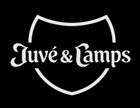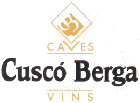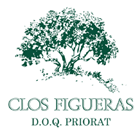Llopart
by
Kathy and Terry Sullivan
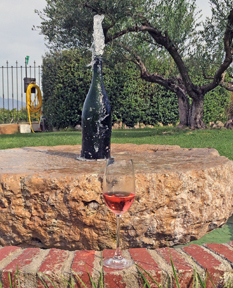 Summary: Combine wine, food, tours, history and a small vineyard library and you have discovered Llopart Winery, the second oldest cava producer. Llopart Winery is located in Subirats.
Summary: Combine wine, food, tours, history and a small vineyard library and you have discovered Llopart Winery, the second oldest cava producer. Llopart Winery is located in Subirats.
The Llopart family has been making wine dating back to the 14th century. It was in 1887 that Llopart began producing cavas. Today the 5th generation Llopart sisters and brothers operate the winery.
We traveled to Llopart Winery in Subirats for a tour, tasting and a catered Catalan-style lunch. By the time we arrived at Llopart, the morning fog had dissipated and we enjoyed the brilliant sunshine. In addition to the small vineyard library in the front of the modern-style building we saw a decorative fountain flowing from a cava bottle.
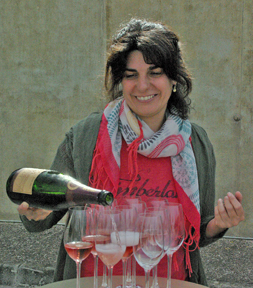 Jesi Llopart, the vibrant granddaughter of the original owners and producers of Llopart cavas, greeted our group and led a tour of the vineyards and winery. Celia Almirall i Valls poured a lovely rosé cava. Rosé Brut was produced with Monastrell, Garnacha and Pinot Noir. The wine was red with an orange hue. The crisp cava with 11.5% alcohol reminds one of red grapefruit.
Jesi Llopart, the vibrant granddaughter of the original owners and producers of Llopart cavas, greeted our group and led a tour of the vineyards and winery. Celia Almirall i Valls poured a lovely rosé cava. Rosé Brut was produced with Monastrell, Garnacha and Pinot Noir. The wine was red with an orange hue. The crisp cava with 11.5% alcohol reminds one of red grapefruit.
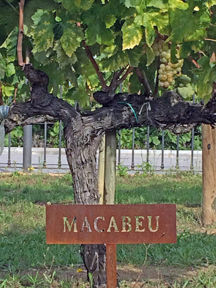 Vineyard Library
Vineyard Library
We noted the indigenous grape varieties used to produce cavas at other wineries. With cava in hand, we ambled to the vineyard library to look at the vines. Each variety is labeled. Since many had fruit on them, Jesi encouraged us to sample the berries. We were able to taste Macabeo, Xarel-lo, Parellada and many other grapes.
Visitors to the winery will discover this small vineyard library in front of the winery with examples of several varietal grapes including: Macabeo, Xarel-lo, Parellada, Chardonnay, Muscat, Monastrell (Mourvedre), Garnacha and Pinot Noir.
Jesi led us into the the front of the building to a collection of pictures and artifacts showing the heritage of the family. Of interest was an old bottle of cava. The cork did not have a wire cage as they do today, rather it was tied with string. We then walked to some of the vineyards on the property.
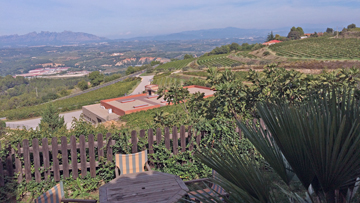 Vineyards
Vineyards
Llopart Winery has 95 hectares (235 acres) of grapes; occasionally the winery needs to source a small percentage of grapes from local growers. The varieties in the vineyards include Chardonnay, Muscat, Garnacha, Monestrell, Parellada, Pinot Noir, Cabernet Sauvignon and Macabeo. The average age of the vineyards is 35 years. Sixty percent of the vineyards are head pruned.
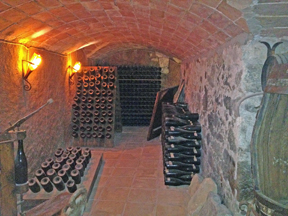 Winery
Winery
We walked from the vineyard to a newer section of the winery where stainless steel tanks were used to ferment wines. We tasted a wine that was fermenting noting the sweetness. From the gleaming stainless steel tanks Jesi led us to the dark caves that held barrels aging wines. Then we went on to the caves that held bottles aging cava. We stopped momentarily to observe the original cave where the family made cava back in 1887.
In a brightly lit area, we stopped for our second cava tasting. Placed in an ice bucket were bottles of the Espumos. Espumos was the name on the old bottle of cava that had its cork tied with string. In 2012, the winery celebrated the 125th anniversary of the first cava made. The Espumos was a blend of Parellada, Macabeo and Xarel-lo This gold color cava offered notes of apple and mineral with hints of freshly baked bread. The 11.5% alcohol cava retails for 35€.
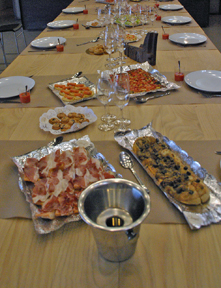 Lunch
Lunch
During lunch we tasted several Llopart cavas and noticed how well they paired with an assortment of different foods. The dishes included:
Roasted vegetables (Peppers, eggplant, onions and potatoes)
Foie gras bread with foie gras
Mushroom tart
Cake tuna
Salmon blini (Salmon filet on petite pancakes)
Corn bread and tomato bread with a jamon thin slice of meat
Crèpe de brandadade bacallà
Pastís d’estiu
Llopart cavas
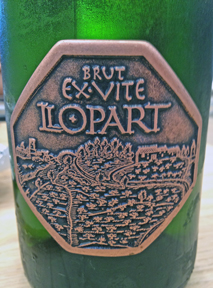 Wines
Wines
During our wine tasting cavas were served in Riedel stemware. Rather than flutes, the cavas were served in white wine glasses.
Microcosmos Reserva Rosé Brut Nature was made with Pinot Noir and Monastrell. The salmon color cava was crisp and refreshing with some citrus notes. The cava was paired with smoked salmon, which quickly cut the salmon aftertaste. The retail price is 25€.
Integral Brut Nature was a blend of Chardonnay, Parellada and Xarel-lo. This light yellow cava had 11.5% alcohol. The crisp cava offered apple and citrus notes.
Ex Vite Brut Gran Reserva 2006 was produced with Macabeo and Xarel-lo. This cava was aged for 72 months. The yellow cava had 12% alcohol. The cava notes included mineral, freshly baked bread, honeysuckle and some yellow stone fruit. This crisp cava retails for 45€.
Dessert Wine
Nectar Terrenal Semi Dulce (Demi Sweet) was a sweet and yellow cava. The cava was a blend of Parellada and Xarel-lo. The wine offered notes of citrus, mineral and apple. The wine was 11.5% alcohol.
When planning a visit to Llopart Winery, be sure to make a reservation.
LLopart Winery
Ctra. de Sant Sadurni a Ordal km 4
08739 Subirats - Els Casots, Spain
GPS:N 41.40792º E 1.80340º
Article written October 2014
Please support the following.
 |
|||
 |
 |
